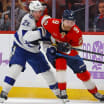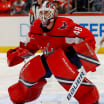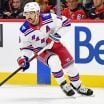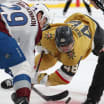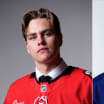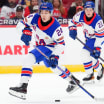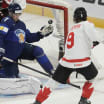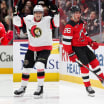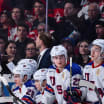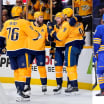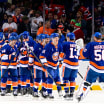Next shot. Next save.
Most goalies use some version of that mantra to stay in the moment, to prevent their minds from wandering during calmer stretches in a game, to stop themselves from dwelling on goals allowed, and to avoid looking ahead and becoming too focused on end results, especially in big games or times when there's a lot on the line.
Unmasked: Goalies find different ways to maintain focus on next shot
Reset routines, breathing techniques, reminders on equipment among ways used to stay in moment
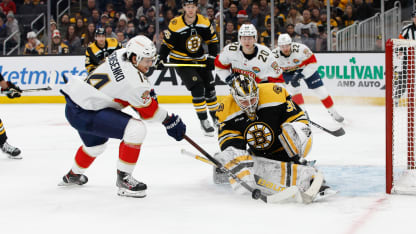
By
Kevin Woodley
NHL.com Independent Correspondent
"As a goalie, you've got to stay in a moment," said New York Rangers goalie Jaroslav Halak, who is in his 17th NHL season. "If you give up a bad goal or the team gives up a few goals in a row, as a goalie you have to have a short memory, you have to turn the page.
"It's easier said than done, but it's the next shot. You've got to try to make the next save and focus on what's going on right now and not what happened or what's going to happen. Stay in the moment."
But maintaining that "next shot, next save" focus always has been easier to say than it is to do.
"It's a skill you have to train for sure," Seattle Kraken goalie Philipp Grubauer said.
Goalies also agreed it may be harder, and more important than ever, to maintain that mindset in today's NHL, as scoring has gone up, there have been wild momentum swings and multigoal leads being blown at an unprecedented rate.
With 109 multigoal comebacks through 913 games played through Tuesday, the NHL is on pace to surpass the record of 138 multigoal comebacks set during 1,271 games played in 2018-19. There were another 199 instances of a team overcoming a multigoal deficit to at least tie a game even if they didn't ultimately win the game.
"I would say that's always been the job, it's maybe just more important now," Seattle goalie Martin Jones said. "Obviously scoring is up and teams are never really out of a game anymore, so it's just a little bit more important to make sure you're sharp for 60 minutes and there's no lapses and you're focused and you maintain that next-shot mentality."
Goalies and their sport psychologists come up with unique ways to do this, from reset routines and breathing techniques, to reminders written on equipment.
"It's about having mental resets," said Boston Bruins goalie Linus Ullmark, who leads the NHL with a .937 save percentage (minimum 20 games). "We all have these small micro-behaviors that get you back into the moment."
And those tools can evolve during a goalie's career.
"It's kind of like golf where you have a swing thought that works for you for a while and you run with that until you find something else and then you go with that," Jones said.
Ullmark has modified his routine this season behind a Bruins team that leads the NHL with 91 points (43-8-5) and can control play for long stretches, leaving him lots of time to watch from the other end of the ice.
"I used to be a very stand-still kind of guy," he said. "I'm just waiting for it all the time. But when you're in games when you're not engaged and you don't get 30-plus shots and you're standing there with 15 shots after 50 minutes, you don't feel great. But if you keep yourself moving and get your eyes up and just moving around, your body stays loose and it's easier to get the flow going and get the game going. It's basics: When you're doing something you think is fun, time just flies by. But if you're just standing still in a room and looking at a clock, it takes forever."
Carter Hart of the Philadelphia Flyers used to reset by spraying a stream from his water bottle high in the air during breaks in play and watch one drop as it fell to the ice to reset his eyes and his focus. It was a method he picked up from former NHL goalie Braden Holtby, who used to work with the same sports psychologist. But Hart stopped doing that several years ago.
"I have different things I do now, things I'd rather keep to myself," Hart said. "But I have a couple little triggers, things I do so that if I do start to drift away, it just brings my focus back."
Grubauer likes to watch the replay after giving up a goal as part of his reset process.
"I always watch it," he said, adding there is an element of self-assessment involved. "But the way I think is, I can't change it, I can't go back and fix a mistake. All I can focus on and control is what happens in the next couple of seconds and my effort towards that next shot."
Some goalies write messages on their sticks or inside their blocker as reminders.
Buffalo Sabres goalie Eric Comrie writes "Breathe-Centered" on the shaft of his sticks.
"In junior it was breathe and vision," Comrie said. "It changed to breathe-centered because of my work with a mental skills coach, who brought up centered to me and said it's a good mantra because it keeps you from going too far over to the happy side and too far to the angry side. You've got to be in the middle. Both can lead to bad things."
Ullmark has "Andas Och Njut" inside one of his blockers, which translates from Swedish to breathe and enjoy.
"Whenever I feel frustrated or something during a game, or maybe if I get myself a little bit too worked up that I feel like I put too much pressure on myself, I just look down and then as a subtle reminder I say it out loud and it manifests better than just thinking it," Ullmark said.
Boston goalie Jeremy Swayman tries to keep an even keel by not showing too much emotion even when the Bruins score, and he refocuses himself throughout the game by skating to the corner during breaks.
"Looking up, eyes up, head up, and just filling your body with dopamine," he said. "Being excited for that next shot."
Flyers rookie Samuel Ersson, who has begun his NHL career 6-0-0, has a personal mantra he repeats throughout the game to anchor himself, along with different breathing techniques.
"As a goalie, that's what it all comes down to, one shot at a time," he said.
For a goalie, the next shot is always the most important.
